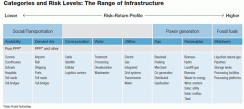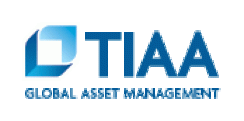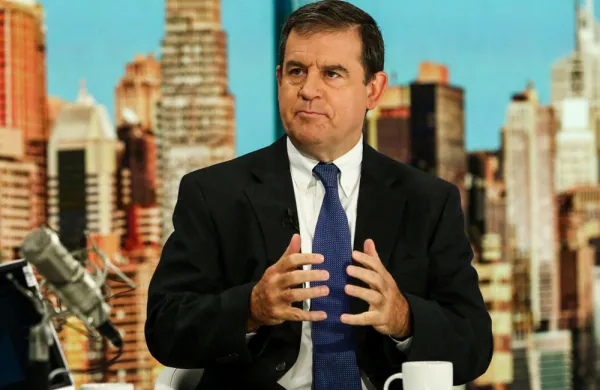To view a PDF of the report, click here.
Rising demand is driven by greater investor appreciation of the stability, lower volatility and investment performance of infrastructure assets.
In recent years institutional investors have increased allocations to infrastructure assets, through private and public investments, as a diversification tool to reduce portfolio volatility and hedge against both inflation and deflation. TIAA Global Asset Management’s Marietta Moshiashvili, sector head of private infrastructure, and Jay Rosenberg, head of investments for real assets at Nuveen Asset Management, discuss the role infrastructure can play as investor expectations for returns from other asset classes continue to diminish.
Definitions of infrastructure vary widely. How do you define this asset class?
Rosenberg: We think of infrastructure as location-specific assets that garner a fee for their use. So we’re talking about assets employed in the movement or transmission of people, energy or communications and the provision of essential services. Importantly, we like to see the fees on infrastructure assets paid through long-term concessions or contracts, which provide enhanced visibility into cash flow. We feel a large majority of the company’s value should be derived from regulated, contractual or concessionary cash flows.
Moshiashvili: We define infrastructure assets as having specific characteristics that include providing essential services for the economy or community; having high barriers to entry and monopolistic qualities as a result of their contractual or regulatory regimes; and benefiting from stable and inflation-linked cash flows over the long term.
We differentiate further by qualifying the assets as core or core-plus, which includes certain energy-related infrastructure. Core covers anything that is regulated, contracted or otherwise predetermined. Core-plus covers assets that are moving from the development stage toward the contractual, mature stage, so they offer a better risk—return profile. There is also a differentiation based on geographic location that leads to various political and regulatory risk considerations.
In the past, some institutional investors have shied away from infrastructure because of low return expectations relative to other investment opportunities. Has that dynamic shifted now with expectations for other asset classes declining?
Moshiashvili: There is rising demand for infrastructure assets, driven by improved investor appreciation for the stability, lower volatility and investment performance of the asset class. There’s also an increasingly attractive investment backdrop. You have greater availability of debt and higher valuations for assets, prompting government and strategic players to realize that this is a great time to reduce their ownership stake in mature core assets in well-developed markets. As such, we are seeing an increasing number of attractive secondary and emerging opportunities in the market.
Rosenberg: Clearly, infrastructure has been made more attractive as falling interest rates have depressed overall required rates of return. A lot of that has to do with the fact that infrastructure as a whole typically displays lower volatility than the broader market. Infrastructure assets, with relatively stable cash flows and greater longer-term visibility, are typically in a good place in this low-return, subdued-growth environment, especially when compared with less predictable and more volatile earnings in other segments of the economy.
Infrastructure investing can also provide the opportunity to get higher growth if you’re willing to stomach higher volatility. There are certain segments of the asset class that have enjoyed tremendous historical growth and volatility, such as energy midstream plays in North America and infrastructure buildouts in emerging markets. The growth and volatility attributes of those assets either match or exceed those of many growth companies out there.
Infrastructure has often been viewed as a hedge against inflation. Doesn’t that make it less appealing in the kind of low-growth, low-inflationary period we find ourselves in now?
Rosenberg: Infrastructure has attributes that make it both an inflation hedge and a deflation hedge. On the asset side, when inflation rises, the replacement cost of these assets naturally rises with the price of labor and materials. On the cash flow side, many infrastructure assets enjoy automatic inflation pass-through in their regulated structure or they have regular rate reviews that allow for periodic changes in the cost of capital. The deflation side is equally if not more important. With suboptimal growth and inflation around the world, you have monetary policies that are providing stimulus, which keeps discount rates low. The current environment is especially conducive to lifting the value of the assets with visible cash flows.
Why are institutional investors, generally speaking, well suited for infrastructure investing?
Moshiashvili: The benefits of infrastructure investment have been tested in volatile and uncertain market environments. A separate allocation to infrastructure in a portfolio allows institutional investors to closely match their long-term and sizeable liabilities with the long-term cash flow profile of capital-intensive infrastructure assets. It also contributes diversification benefits, reliable inflation-linked returns and low correlation and volatility when compared with traditional asset classes. The asset’s capital-intensive nature allows investors to put significant investment dollars to work.
Rosenberg: Infrastructure also plays to the advanced capabilities of institutional investors. The valuation of infrastructure assets is very detailed and modeling-intensive, as you have contracts or concessions with varying fixed-ending lives. Traditional multiples such as return on equity and traditional fundamental analysis won’t help given the finite lives of the cash flow streams, which distort fair value. So it takes a level of sophistication to really understand the value proposition of infrastructure, and well-resourced institutional investors tend to be well suited for that.

What should you consider when comparing private versus listed infrastructure?
Moshiashvili: Private infrastructure investments can add significant diversification benefits to institutional investors’ portfolios. Investing in unlisted infrastructure represents a customized approach for any investor who wants to have a particular geographic or sectoral concentration, because you have the ability to select an asset. That ability is not always present in the public markets. Exposure to unlisted infrastructure also allows for better governance. Whether you’re a controlling investor or you have negative control provisions as part of a consortium, you have influence over the strategy of the investment, its capital structure and the operating risk associated with it. This lends itself well to those looking to create value through active growth strategies and management of the asset, whether it’s through operational maintenance, improvements or some other means.
Rosenberg: Public and private ownership strategies can be very complementary, providing access to a wide range of assets and return and volatility profiles. The diversification potential of a listed strategy can mitigate some of the regulatory, political and natural-disaster risks to these assets. That’s because you can hold shares of a wide-ranging collection of assets and regions, which dilutes those types of risks. A listed strategy also gives you real-time liquidity, allowing you to reposition your portfolio in an ever-changing environment. In addition, many mission-critical or gateway assets, such as some of the largest seaport assets in China and major airports, including Sydney and Charles de Gaulle, can be found in the listed marketplace.
To what extent have public-private partnerships contributed to the rising popularity of unlisted infrastructure assets?
Moshiashvili: Privatization has certainly played a critical role in the asset class, starting in Europe and Australia and now increasingly in North America. Private foreign investment regimes were instituted as early as the 1990s in the U.K. but took some time to catch on elsewhere. Today there is a potent combination of trends pushing for more privatization of public infrastructure: population growth, constrained government budgets and high levels of public debt. And now it’s finally reached the U.S., where we have seen tremendous growth in public—private structures over the past five years that has pushed private investment beyond the more traditional power assets. You have 33 states and Puerto Rico that are privatizing through their legislative regimes. They invite private capital in for financing or improvements or construction of transportation assets or for operation of some social infrastructure assets, like schools, courthouses and hospitals.
With all of the attention on infrastructure investments, what has that meant for competition for publicly held assets?
Rosenberg: There is significant competition for very high-quality assets. We’re in a period of subdued growth globally, and required rates of return are quite low. This is raising the appeal of very high-quality, highly visible cash flows, particularly in very stable political and regulatory environments. As a result, we’ve also seen substantial M&A interest in those types of assets, such as in the North American regulated utility sector. There has also been significant interest in regulated assets in other stable political and regulatory environments, such as the U.K. and Australia. When these types of assets come up for sale, there tends to be a significant amount of capital chasing them, often coming from the big pension plans and sovereign wealth funds.
What are the trends driving the supply of new infrastructure opportunities?
Moshiashvili: While you do have a lot more players competing in the private infrastructure space, particularly in the well-developed markets where contracts are highly enforceable, there are new trends creating fresh infrastructure opportunities, despite the valuation and competition concerns. You have the basic fact that we need to build out our infrastructure due to population growth. You have scarcity of natural resources, prompting the expansion of our energy infrastructure. You have the urbanization trend contributing to constrained budgets on the public debt side. You also have some disruptive shifts, such as climate change and the regulations being passed that are forcing new modes of energy distribution and measures promoting efficiency. Then there are changing human behaviors, such as people wanting everything delivered to their door, which will have profound implications for shipping infrastructure. These are just a few of the influences that create new market trends and should be considered by institutional investors when evaluating infrastructure.
Rosenberg: Infrastructure assets are diverse. With so many different types of assets and geographic areas, opportunities are still abundant and attractive. Acceptable valuations can still be found, and additional opportunities will surely arise, given the ever-changing commodity markets and political and regulatory environment.
Real asset investments may be subject to environmental and political risks and currency volatility. Investments will be subject to risks generally associated with the ownership of real estate—related assets and foreign investing, including changes in economic conditions, currency values, environmental risks, the cost of and ability to obtain insurance and risks related to leasing of properties. Diversification is a technique to help reduce risk. There is no guarantee that diversification will protect against a loss of income.
The material is for informational purposes only and should not be regarded as a recommendation or an offer to buy or sell any product or service to which this information may relate. Certain products and services may not be available to all entities or persons. Past performance does not guarantee future results.
TIAA Global Asset Management provides investment advice and portfolio management services through TIAA and over a dozen affiliated registered investment advisers.
©2016 Teachers Insurance and Annuity Association of America—College Retirement Equities Fund, 730 Third Avenue, New York, NY 10017 C33691
Contact Information

John Panagakis
Head of Global Private Distribution
TIAA Global Asset Management
JPanagakis@tiaa.org

Lynne Harrington
Head of Institutional Sales and Client Service
Nuveen Asset Management
Lynne.Harrington@Nuveen.com
3 - GOLD OUTSHINES THE MARKET





